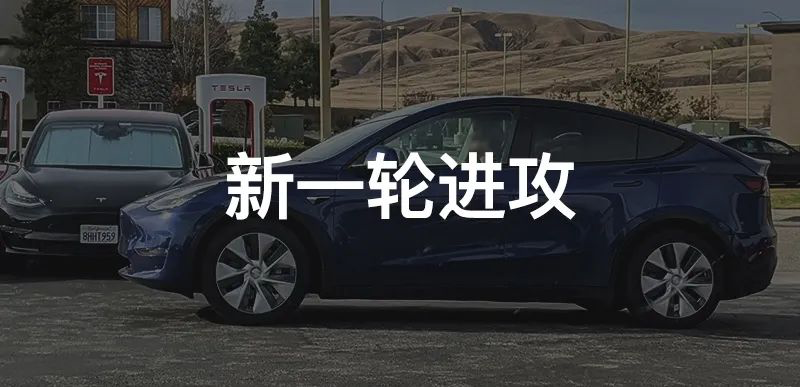Tesla Launches New Offensive
Tesla is launching a new round of attacks.
Since news of the early delivery of Model Y was exposed, various images and videos of Model Y have appeared online, including pictures of Model Y ready to go outside the factory.
According to Tesla’s plan, Model Y was originally scheduled to be delivered in the fall of 2020. However, in Tesla’s Q4 2019 financial report released on January 29, 2020, Tesla officially stated that Model Y would begin production in January 2020 and delivery would begin in the first quarter.
For Tesla, delays have become commonplace. The early delivery of Model Y is obviously a deviation from convention.
So a core question arises: How can Model Y be so fast? What happened behind the scenes?
This article will revolve around this core question to elaborate.
Model Y with New Production Technology
Undoubtedly, one of Tesla’s biggest problems is insufficient production capacity.
To solve the problem of insufficient capacity, there are mainly two directions: one is to increase the number of factories, and the other is to improve production efficiency.
From the Shanghai Super Factory to the Berlin Super Factory in Germany, Tesla’s determination to move forward can be seen. However, building factories is limited, so increasing factory production efficiency has become an essential path. So Tesla has split into two paths and is working in both directions.
Tesla is also very clear that creating a more efficient production line can also benefit the production of all major super factories in the future.
Therefore, Tesla came up with a solution: a fully automated factory.
As the name suggests, a fully automated factory relies entirely on machine operations without human intervention.
Initially planned was Tesla’s fully automated factory – The Alien Dreadnought. According to the original plan, the factory was to be used for the production of Model 3, and the automated production line for Model 3 was called Dreadnought 0.5. The production line for Model Y would be stronger and would be called Dreadnought 3.0.It sounds great, and Musk was once very ambitious, and boldly claimed that “this will achieve (really crazy) efficiency improvement, for other car manufacturers, this will be a very difficult thing. If I stand in their shoes, I don’t know how to deal with it.”
As Musk himself said, he really didn’t know how to deal with it. The plan was not long before it was declared a failure, and Musk paid a price of $ 2 billion according to Bernstein Research’s evaluation.
Later, in an interview with Marques Brownlee, Musk also admitted, “We made a mistake, which is a serious mistake. We tried to automate the final assembly process. But some tasks are too difficult for robots, such as trying to connect a flexible hose that will sway. The robot will try to find the hose, grab it, and connect it to another harness. But the robot will grab the wrong thing and plug it in the wrong place. The harness is clearly here, but the robot thinks it is there. At this time, it will grab nothing and then fling towards the car. It’s simple for humans, no matter how it’s placed, humans know how to operate it. This is really a ridiculous mistake, very tragic.”
Image from Marques Brownlee interview video
Since then, the fully automated factory has come to an end.
But this is far from over, improving production efficiency is still one of Tesla’s important strategies. Musk has also said that “part of the automation level of the factory production line has reached 80-90%.” If efficiency is improved from this part, the production speed will also be faster.
Therefore, in Tesla’s Q4 2019 financial report, Tesla released several pictures of the Model Y production line, but just these few pictures have caused major foreign media to analyze them eagerly.
Picture source: Tesla 2019 Q4 financial report screenshot
Among them, German engineer Holger Erker analyzed and concluded that “Model Y uses huge frame castings, compared with traditional stamped steel body, the total production time of Model Y’s white body will be greatly reduced.”And how much will the production time of Model Y be reduced? Holger Erker said, “Excluding the net processing time of the bottom of the vehicle body, the casting eliminates 1000 to 1500 welding points, each of which requires 5 to 7 seconds. In total, about 120 minutes of time can be saved.”
What does that mean? In other words, after analyzing it, Holger Erker found that the white body of Model Y has adopted a new production process that uses large castings, which reduces welding points and, ultimately, production time.
As a result, the reason for the early delivery of Model Y is becoming apparent.
But analysis alone is not enough. What exactly is the new process adopted by Tesla? This also requires an answer. Here we have to mention Tesla’s “Method and Apparatus for Multi-Directional Casting of Vehicle Frame” patent.
Tesla’s Evolutionary Technology: “Integral Casting Body”
In July 2019, according to Electrek, Tesla has a huge new machine that can almost produce an entire white body of Model Y. Reviewing the patent, whose number is US20190217380 and entitled “Method and Apparatus for Multi-Directional Casting of Vehicle Frame.”
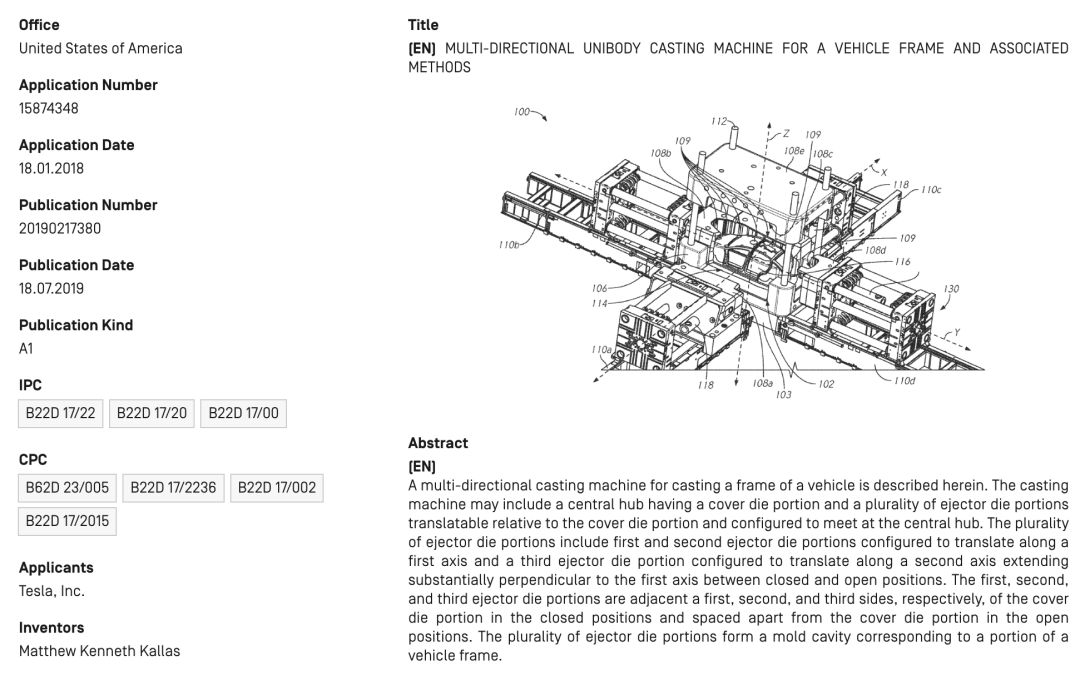
Image from WIPO
In Tesla’s words, the background of the patent invention is that usually the white body is manufactured by using multiple stamping machines to produce different components of the body.
For example, a stamping machine in the factory may be dedicated to a certain part. When these parts are all produced, they need to be welded together by workers or robots to form a complete white body.
These individual parts will also bring problems, for example, if the stamping machine is responsible for one component, then multiple components will require multiple machines. This will result in more capital and time costs during manufacturing.
Therefore, Tesla invented this patent to reduce manufacturing-related costs, including but not limited to factory operation costs, tool costs (the number of equipment), time costs, and labor costs. In other words, it reduces time and capital costs.
Patent Description
The patent describes a multi-directional casting machine that can be used to cast an integrally shaped vehicle frame, specifically designed to manufacture electric vehicle body frames. Multiple parts of the body can be manufactured integrally without the need for further assembly and welding. Overall, this reduces the number of parts and operating steps of the body.In simple terms, the car frame parts are integrated together to form a large module, such as directly casting the entire side of a car body. Then, these large modules are assembled through automation and welded together to form a complete car body, effectively reducing intermediate steps and further speeding up efficiency.
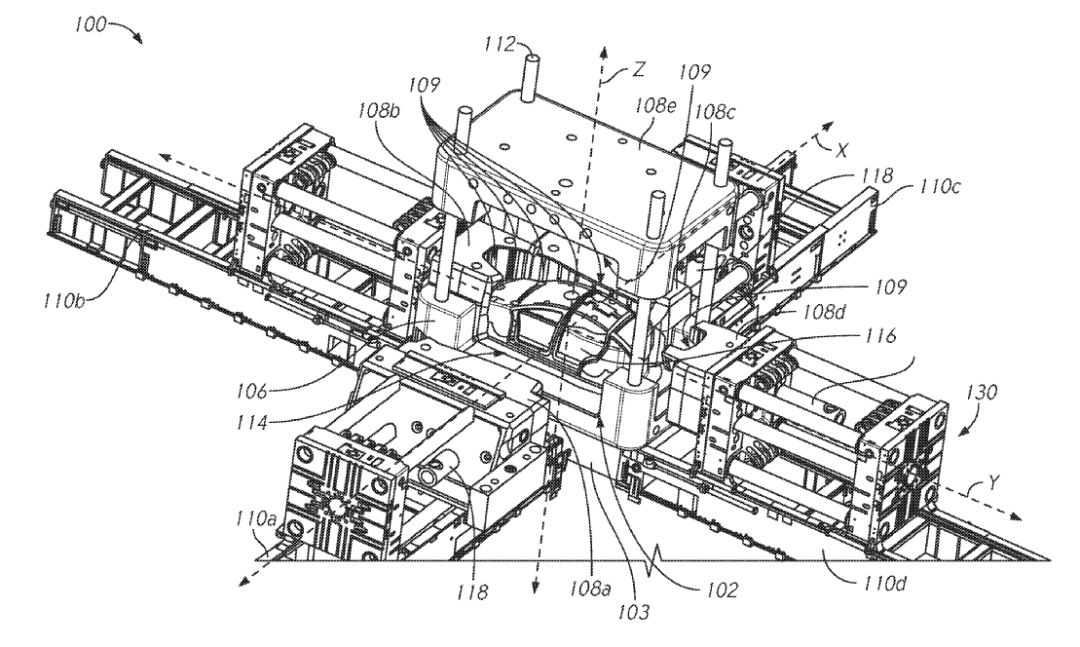
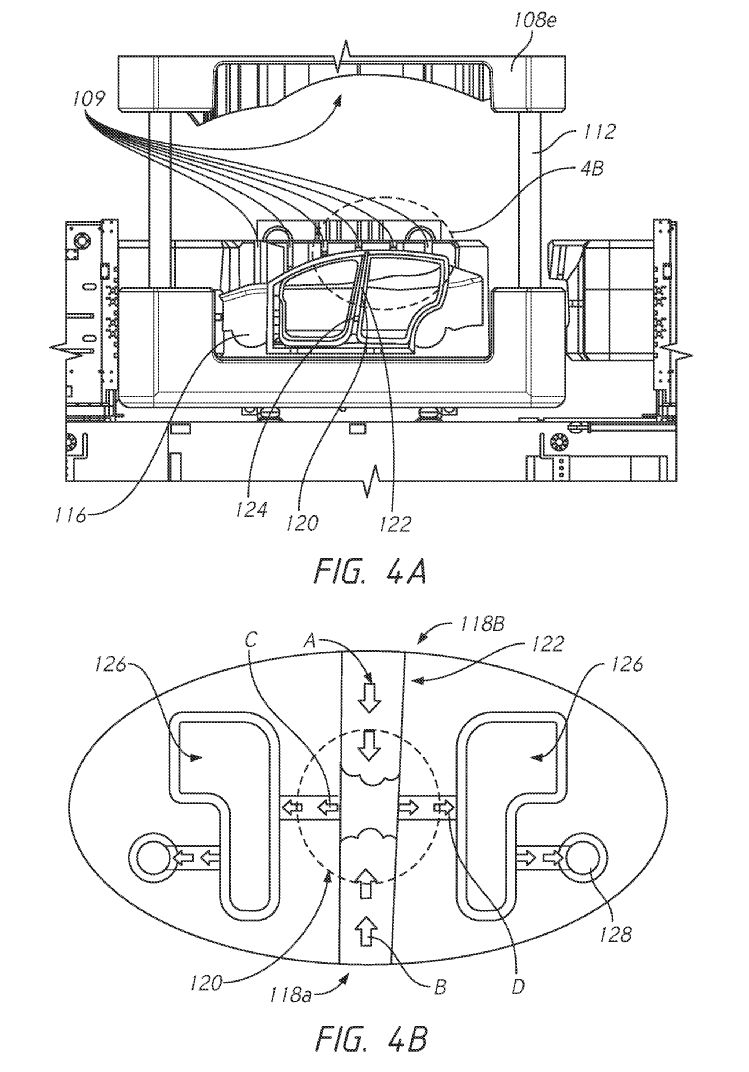
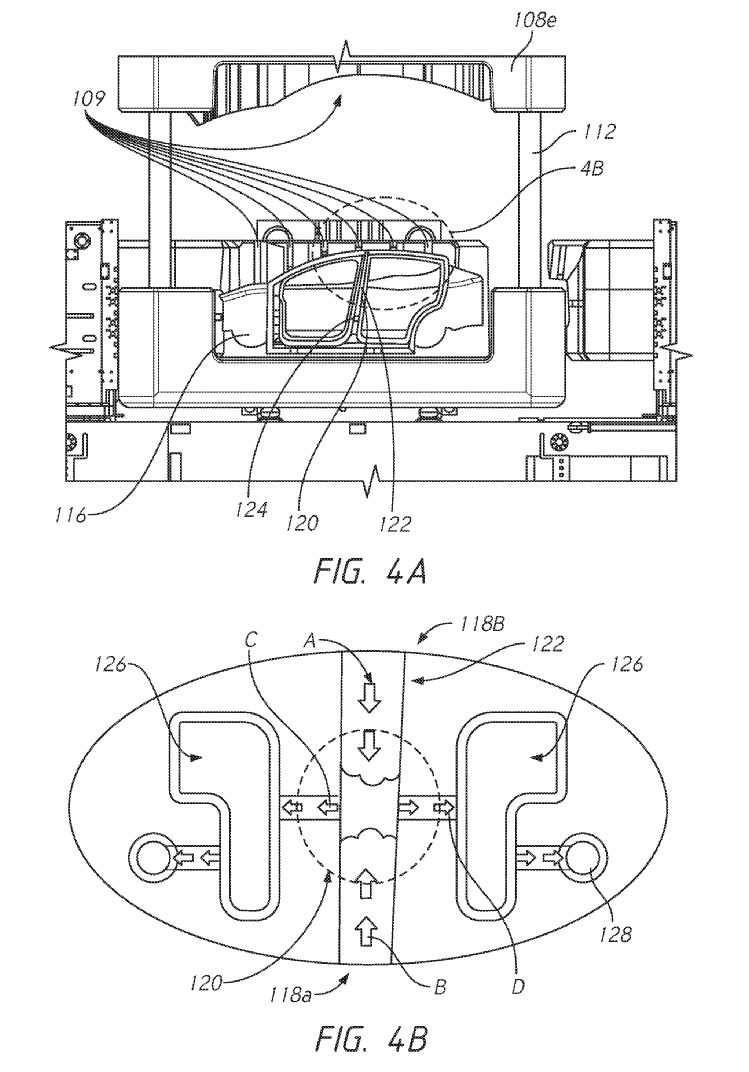
Image source: WIPO
Taking a closer look at the patent diagram, the steps described in the patent are relatively complex. Simply put, the car body is first separated into several large modules to be manufactured. These large modules are completed by the machines shown in the upper, left, right, front, and back of the figure, which we can temporarily refer to as “5 workers”.
After the “5 workers” complete the modules, they are assembled together to form a half-finished white car body. Then, a small amount of welding is used to connect them together to form a complete white car body.
Regarding how these “5 workers” manufacture the large modules of the white car body, the patent indicates that the casting method will be used. In other words, each of the 5 workers has a mold, and by injecting molten metal into the mold, they can obtain the various modules of the white car body, which can then be assembled together.
With an understanding of the patent, we can better interpret the analysis of German engineer Holger Erker.
Concept Become Reality?
In addition to the conclusion mentioned above, German engineer Holger Erker also conducted a deep analysis of the pictures in Tesla’s Q4 2019 financial report. He stated:
“From the photos of the Model Y white body in Tesla’s Q4 2019 financial report, it can be seen that the white body of the Model Y is made of multi-material mixtures, similar to the white body of the Model 3. However, unlike the Model 3, the Model Y’s white body is composed of four main components, including the rear casting, front casting, BS Asm LH (left body component), BS Asm RH (right body component), thin sheets, and closed parts.”

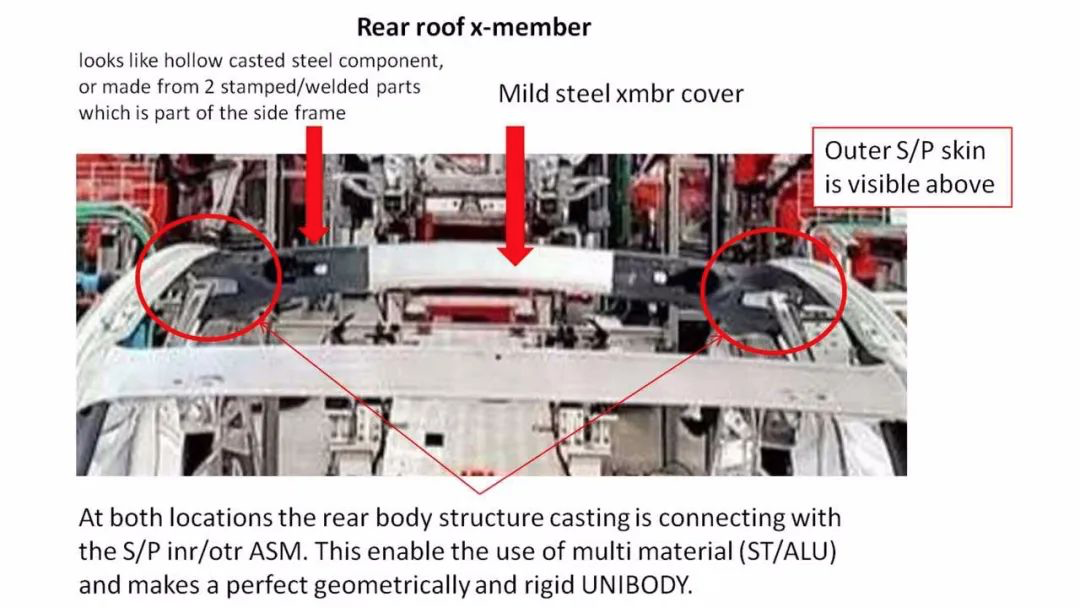
Image source insideevs
In other words, the Model Y has utilized the integrated body parts described in the patent. According to Electrek’s speculations, Tesla may have produced two large castings, one of which is used to fix the engine.
Next, Holger Erker explained:
“The white body is divided into three parts (inner, outer, and rear), and the internal and external structures are made of HSS (high-strength steel) or UHSS (ultra-high-strength steel) stamped steel plates. Because of the high tensile strength, the panel can only be formed by hot pressing. Therefore, we can find visible heat marks on the panel.
What’s more interesting is the A-pillar and B-pillar sections. It seems that this section is individually stamped and then welded to the wheel rim plate of the car door, and finally forms the side of the body.”
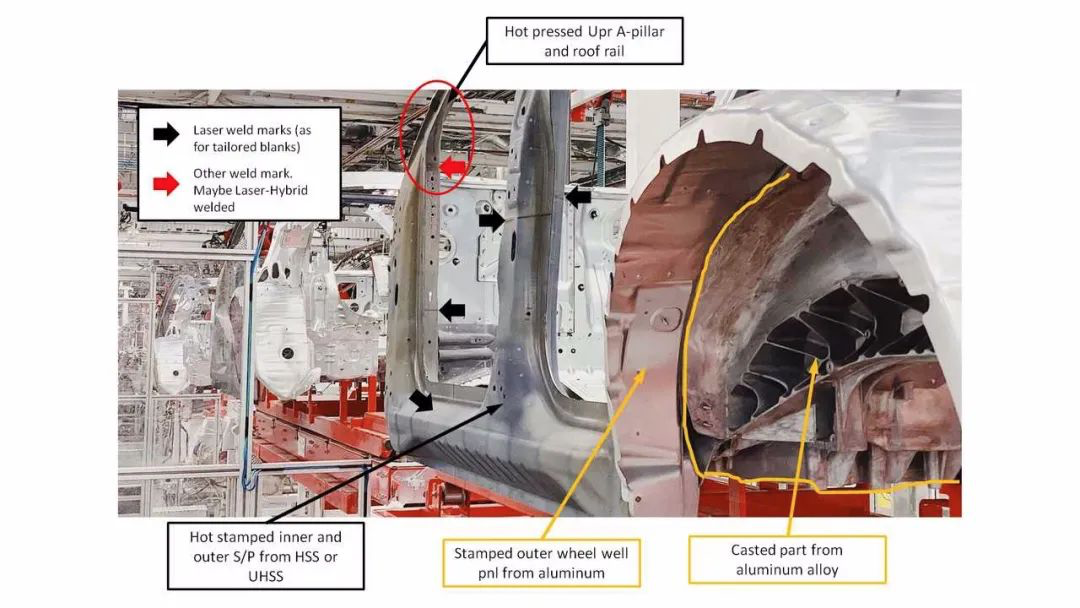
Image source insideevs
Looking at the picture, this analysis just fits the description in the patent that “multiple parts of the body can be manufactured integrally, without the need for further assembly and welding“. As Holger Erker said, the side of the body and the interior are two parts, so where is the third part? He said it is the rear of the body, “which is composed of a super large casting. The casting includes rear longitudinal components, crossbeams, and components for the powertrain. All mounting points for the internal wheel housings also have geometric shapes of “XYZ”. The casting also includes a C-pillar structure that extends upward to the rear roof crossbeam.”
To further prove this, Holger Erker said, “This casting process is definitely very advanced, because the size and weight of the castings have exceeded the known range of all car parts today. The manufacturing process requires HPDC (high-pressure die casting) to be completed on a cold chamber pressure casting machine with vacuum support to avoid defects caused by casting, such as holes, bubbles, cracks, etc. Roughly estimated, the weight of the rear body component is about 40 to 45 kilograms. For reference: the casting rear longitudinal member of the Audi A8 weighs about 10.5 kilograms.”

Image source insideevsHolger Erker also said that since the front structure is also a casting, at least two large machines are sufficient to meet the production requirements.
Therefore, it can be inferred that the new technology used in the Model Y body-in-white production process has basically met the description in the patent.
And if the above inference is correct, everything will be very fast. Holger Erker said, “The body assembly workshop may only need two production lines, one for body assembly and the other for welding the body side, which is only 60% of a traditional body repair shop. Assuming that the entire casting cycle, including all processing and preparation work, can be completed in less than two minutes, the maximum annual output of the casting machine will reach 150,000 parts.
As a result, compared with traditional stamped steel body, the total production time of the Model Y body-in-white will be greatly reduced. Considering the net processing time of the bottom of the body, the casting will eliminate 1,000 to 1,500 welding points, and each welding point requires 5 to 7 seconds. A total of about 120 minutes can be saved.”
From this perspective, the reason for the early delivery of the Model Y has basically come to light.
Why is it basically? Because the underwater part of the Model Y may have more advanced technology. That is Tesla’s patented new wiring system architecture. This may also be one of the reasons for the early delivery of the Model Y.
Revolutionary New Wiring Architecture in Tesla’s Technological Evolution
However, based on the currently available information, we do not know whether the Model Y has adopted this new technology.
But it is certain that once the soon-to-be-delivered Model Y uses the technology of this patent, the traditional automotive industry will be further disrupted. Traditional automakers will face another storm.
Looking back at the patent, its number is US20190217794, and the name is Wiring System Architecture.
On the homepage of the patent, Tesla explains that “this is a new wiring system for automobiles, including power and communication systems, which contains multiple devices. Among them, the system is connected to the backbone part with an external sheath, divided into the first conductor arranged in the external sheath and the second conductor arranged in the external sheath. It is a pair of shielding components set on the opposite side of the external sheath, connected by conductors.”
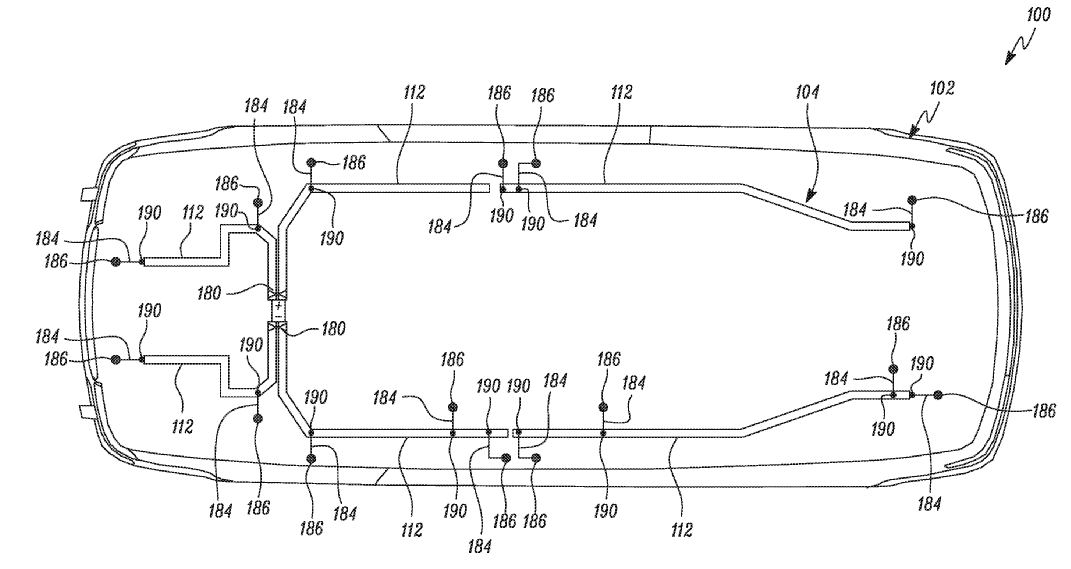
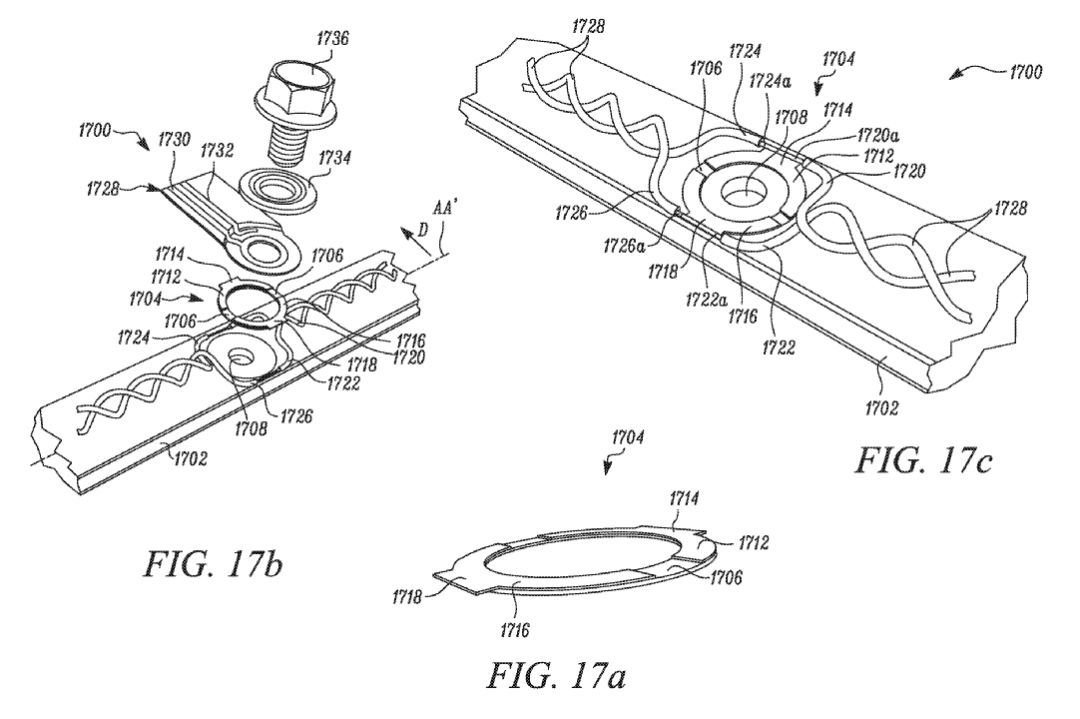
Image source: WIPO.The purpose of this improvement, much like the “whole-body casting” technology, is to improve production efficiency and reduce capital and time costs. As Tesla puts it, traditional cables, such as power cables, USB cables or HDMI cables, are easily manipulated by human hands. But the installation of these cables is difficult to automate because of their lack of sufficient structural integrity and rigidity, making it difficult to pick up, move and place them with a mechanical arm.
Moreover, since traditional cables are not rigid components, they may not readily form different shapes and be installed in predetermined positions under narrow space constraints. Wiring traditional flexible cables during manufacturing is usually not feasible to automate, so manual placement is required, which is time-consuming, tedious and expensive.
The advent of this technology will replace traditional wiring structures, thus reducing operating time and a range of capital costs associated with traditional technology. According to earlier reports by Electrek, Tesla has revealed a revolutionary new wiring architecture that can enable more robotic automation during the manufacturing process and use fewer materials for upcoming vehicles like the Model Y.
Whether from a corporate strategy or foreign media analysis, all signs lead to endless possibilities. But what will be the final outcome? Has Tesla conquered both these technologies? Once the Model Y is officially delivered, all will be revealed.
What is certain is that the Model Y is not just a “fattened up Model 3.”
So, prepare to see the disassembly!

Image source: 24hitech.ru
Final Thoughts
As mentioned earlier, the biggest shortcoming of Tesla is currently its insufficient production capacity. The early delivery of the Model Y indicates that Tesla has overcome its last obstacle, and thus, the Tesla army is advancing toward the automotive industry.
Speaking of the Model Y, the root of its differentiation is its technological advancement. In the fiercely competitive and cruel automotive market, Tesla has achieved differentiation through technology, found its own path to development and growth and achieved a beneficial cycle of profitability, research and development, profitability and research and development through cost control.
In Musk’s own words, this differentiation is “Engineering is true magic.”
So, traditional automakers, are you ready for the impending storm?
This article is a translation by ChatGPT of a Chinese report from 42HOW. If you have any questions about it, please email bd@42how.com.
